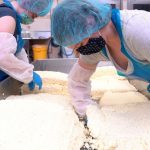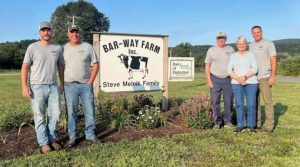
Fonterra, the largest dairy company, produces 20 per cent of the country’s greenhouse gas emissions, with 90 per cent of those generated by its farmers, and effluent from cows has polluted the soil, aquifers and waterways.
Under Fonterra’s new chief executive Miles Hurrell, sustainability has become a key focus as he shifts the co-operative’s attention away from global expansion and back to its core in New Zealand.
“Dairying is all about the land, so if we don’t look after that, we don’t have a future,” says Fonterra’s director of research and development Mark Piper.
“We have been farming for 150 years in New Zealand and we want to be farming for the next 150 years, and we can only do that if we look after the land, the animals and the people,” Piper says.
The co-operative says there is no “silver bullet” to remedy the environmental impact, but it is betting innovation, improved genetics and changes in farm practices will allow the country’s biggest export industry to continue.
“We don’t see any one solution to this,” Piper says.
“We are looking at pretty much everything that is coming out around the world at the moment. It is a global problem to solve.”
Fonterra scouts for new solutions globally and locally and has a set of criteria that must be met:
Is it going to be good for the cow?
Is it going to be good for the milk?
Will it work?
Is it scalable? If it’s a great idea but can only service five cows it won’t be taken up.
Can it work in New Zealand’s grass-fed system?
It can’t affect animal productivity.
It has to be financially viable. If it costs more than a farmer earns in a year is not going to get taken up.
The most advanced projects include a collaboration with Dutch company Royal DSM around the feed additive Bovaer, which reduces methane emissions from cows. The evaluation has moved from the lab to small scale cow trials, and if that is successful, will progress to larger scale cow trials.
There is also a collaboration with Australian company Sea Forest on a red seaweed extract supplementary feed for cows which could help reduce methane emissions. A trial is underway in Tasmania.
The co-operative has partnered with AgResearch and the Pastoral Greenhouse Gas Research Consortium to tap into its large collection of dairy cultures to create new fermentations it’s calling Kowbucha, which could inhibit the methanogens that create methane in cows. Early lab trials are quite promising, but it hasn’t yet moved to cow trials.
It has also partnered with its customer Nestle and industry organisation DairyNZ on the use of plantain in a cow’s diet to reduce the nitrogen concentration in their urine, which can leach through into groundwater, and help mitigate nitrous oxide emissions. Fifty farms in Tararua have been growing the leafy herb as part of the trial.
Fonterra has its ear to the ground locally through its support of the Sprout agtech and foodtech start-up incubator, where about 200 people each year pitch innovative ideas for development.
Alongside that, Fonterra is working with livestock genetics companies LIC and CRV to develop animals that are converting feed effectively into milk, reducing greenhouse gases and with a lower nitrogen output.
Fonterra is also rolling out assessment tools to its 10,000 farmer suppliers. By the end of this financial year, half its farmers will have their own tailored farm environment plan that measures their farm against good farming practices and rates how they are going, where they could improve and where they are strong.
The plan is part of a farm reporting pack delivered to farmers each November which also assesses their nitrogen and emissions and how they rank against their peers. Armed with knowledge, farmers can then take action.
“If you know firstly what your number is, that’s a great first step in being able to then manage for it,” says Fonterra’s Farm Source director Richard Allen. “You can then take actions and implement some of these different mitigation tools and technologies that are going to be rolled out.”
He doesn’t see a “silver bullet” emerging to solve all problems.
“It will be a combination of good farming practice, the right science, the right genetics, and how that all comes together will be quite an individualised recipe for each farm,” he says.
Allen says all issues are important.
“You can’t separate emissions without talking about nitrates, and without talking about the overall farming practices because the farm is an interlinked biological system and you need to have equal weighting and understanding on all of them,” he says.
From the start of the new dairy season in June, Fonterra will reward its farmer suppliers who meet sustainability and milk quality measures, with 10 cents of each farm’s milk payment at stake.
“The way that we farm will continue to evolve,” Allen says.
“I don’t actually see a destination. We will continue to need to adapt and change.”
Farmers have come a long way but there’s still “a helluva lot more to do,” he says.
“There’s a fair way to go to rebuild the pride in agriculture.”






















